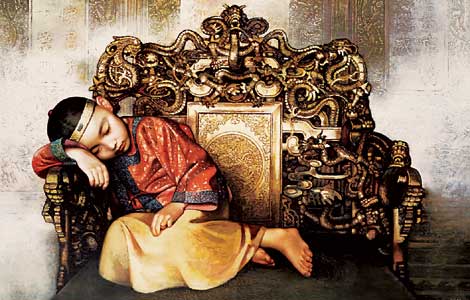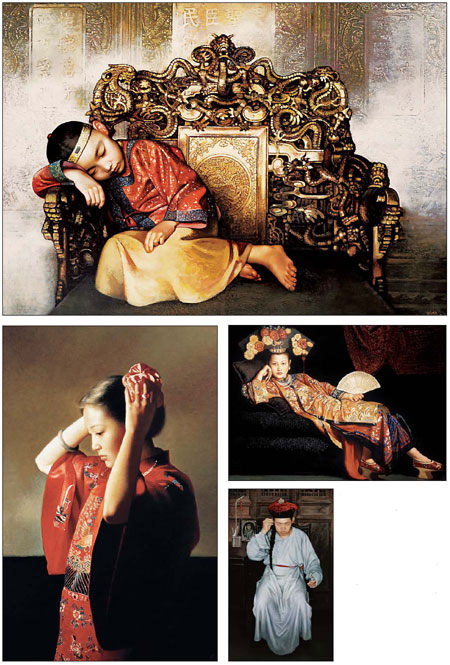Heritage
Lifting the veil
Updated: 2011-08-05 08:00
By Yu Wentao (China Daily)
|
|
Rich in content and exquisite in design, Ah! The Forbidden City is a collector's item. Yu Wentao reports.
Beijing's Palace Museum, also known as the Forbidden City, is steeped in history, dreams and tears, which are perfectly reflected in Ah! The Forbidden City.
Li Shaobai's photos and Jiang Guofang's paintings, in the book published in English by the Foreign Languages Press, are both easy on the eye and provide food for thought.
In 1406, Zhu Di, the third emperor of the Ming Dynasty (1368-1644), assembled 200,000 to 300,000 workers to build the Forbidden City, which took 14 years.
The Hall of Supreme Harmony, as the largest and highest ranking architectural structure in the Forbidden City, surpassed all buildings of its time.
In 1421, the Ming Emperor Yongle moved the capital from Nanjing, Jiangsu province, to Beijing, and the Forbidden City became the home and ruling seat of 24 emperors, 14 of whom were Ming, and 10 Qing (1644-1911). The line ended with Puyi, China's last emperor, who was driven out of the Forbidden City, 13 years after the Revolution of 1911.
When the Palace Museum is open, the sense of history can easily be lost in the flood of visitors. Photographer Li, however, always waits for the right moment to catch the perfect shot.
The empty halls, quiet courtyards, doors and windows with fading paint, and long grass in the corners of the squares, evoke a strong sense of history.
Li has taken photos of the imperial palace for nearly 20 years and says it changes according to the season, weather, light and shadow.
"Beauty exists everywhere. One must be sensitive to discover and catch it," the photographer says.
|
Dream, a young emperor dozing off on the golden throne. Princess, a beautiful woman who can't conceal her loneliness. A Eunuch in the Forbidden City, one of the most controversial figures in the palace. Makeup for the Night, a palace maid dresses up to impress the emperor. |
Painter Jiang, meanwhile, tries to revive the lives of the former inhabitants of the Forbidden City on canvas, getting into the minds of these historical figures.
Their joint efforts deepen our understanding of the past lives of the imperial families.
Jiang began producing artworks based on the Forbidden City in 1987 and has established a strong reputation in art circles because of this work.
Based on historical materials and an active imagination, he has created a series of images that include dignified emperors, pretty palace women, humble eunuchs and maids. The figures are so vivid and lifelike that viewers can almost feel their breath.
As the Son of Heaven, the emperor possessed supreme power and controlled all the people "under heaven".
In addition to painting the rulers of the day, Jiang likes to paint likenesses of the child emperors. Wearing an imperial robe and sitting on a golden throne, the child emperor eats a cherry with great relish, ignoring the ministers and eunuchs standing beside him. The imperial authority and childhood innocence form a stark contrast.
It often happened that when the crown prince succeeded to the throne after the death of the emperor, he was still a child and required the empress to reign behind the scenes. During the Ming and Qing dynasties, there were five such child emperors.
Jiang's oil paintings also reveal the story of the palace eunuchs. On the one hand, they were damaged and humiliated by being castrated. On the other hand, they earned favor as they served the emperor and his family members day and night. Once the eunuchs gained the trust of the emperor, they could sometimes behave without scruple, such as issuing unauthorized imperial decrees, taking bribes and framing loyal ministers.
Jiang also has an eye for pretty palace women, including the empress, concubines and princesses. Although they dressed in gorgeous clothes and ate delicious food, they were spiritually bereft. With so many women serving one man, few of them had the chance to be with the emperor. Their rooms were often empty and perhaps the high walls and deep courtyards were like gilded cages to them.
While sympathizing with the fate of palace women, Jiang worships their beauty. Although their bodies are often obscured by the layers of loose and soft coats, robes and skirts, their beauty is obvious for all to see.
Rich in content and exquisite in design, Ah! The Forbidden City deserves appreciation and is a collector's item.
The royal palace was a place full of profundity and one book cannot capture all its moods and depths, but it is a great departure point for visitors to learn more about the Forbidden City, its architecture and learn anecdotes about the people who lived there.

Specials

Lifting the veil
Beijing's Palace Museum, also known as the Forbidden City, is steeped in history, dreams and tears, which are perfectly reflected in design.

My Chinese Valentine
Local businesses are cashing in on a traditional love story involving a cow herder and a goddess

Space race
Homebuyers are learning the hard facts of supply and demand: too many cars and too few parking spaces.

